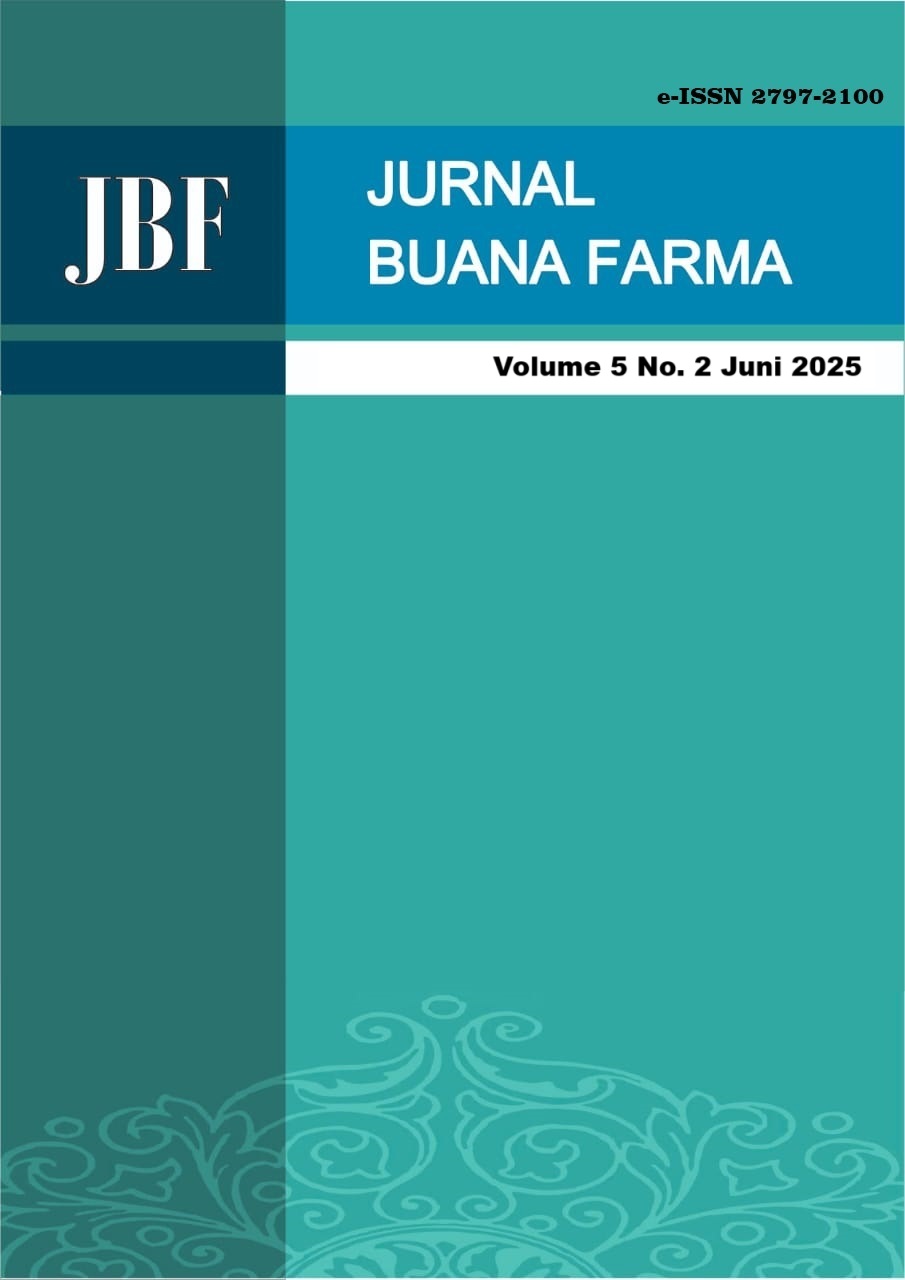AKTIVITAS ANTIJAMUR EKSTRAK ETANOL DAUN KARI TERHADAP Candida albicans ATCC 14053
Abstract
Medicinal plants are recognized as valuable sources of secondary metabolites with therapeutic potential. Candidiasis caused by Candida albicans is a common health problem in tropical regions. The prolonged use of synthetic antifungal agents may lead to resistance, highlighting the need for effective natural alternatives. Curry leaves (Murraya koenigii (L) Spreng) are known to contain flavonoids and alkaloids with potential antifungal activity. This study aimed to evaluate the antifungal activity of the 96% ethanol extract of curry leaves against Candida albicans ATCC 14503. The extract was prepared by maceration using 96% ethanol as the solvent. Phytochemical screening revealed the presence of flavonoids and saponins. The antifungal activity was tested using the disc diffusion method at concentrations of 6,25%, 12,5%, 25%, and 50%. Ketoconazole was used as positive control, while 96% ethanol served as a negative control. The test was performed in triplicate, and the inhibition zones were measured and averaged. The results showed that the 96% ethanol extract of curry leaves at all tested concentrations did not exhibited antifungal activity against C. albicans as indicated by the absence of inhibition zones on the media. It can be concluded that the extract, under the given conditions, was not effective in inhibiting fungal growth. This suggests that the extraction method and tested concentrations may not have been sufficient to isolate or concentrate the active compounds. Further studies using alternative extraction techniques, higher concentrations or isolated compounds are needed to better evaluate the antifungal potential of M. koenigii.
References
Abdallah, E.M. et al. (2023) ‘Back to Nature: Medicinal Plants as Promising Sources for Antibacterial Drugs in the Post-Antibiotic Era’, Plants, 12(17). Available at: https://doi.org/10.3390/plants12173077.
Ajeng Kurniati Roddu, U.I.T.M. and Andi Ulfah Magefirah Rasyid, U.I.T.M. (2021) ‘Uji Efektivitas Antibakteri Sediaan Sabun Cair Ekstrak Daun Kari (Murraya koenigi (L) Spreng) terhadap Candida albicans’, Journal of Pharmacy, Medical and Health Science, 02(September), pp. 86–100.
Batra, P. et al. (2015) ‘Naskah publikasi uji aktivitas antibakteri ekstrak etanol daun mangga bacang’, Orphanet Journal of Rare Diseases, 21(1), pp. 1–9.
Cahyaningsih, R., Magos Brehm, J. and Maxted, N. (2021) ‘Gap analysis of Indonesian priority medicinal plant species as part of their conservation planning’, Global Ecology and Conservation, 26, p. e01459. Available at: https://doi.org/10.1016/j.gecco.2021.e01459.
Chandra, P.P.B. (2024) ‘Skrining Fitokimia dan Penetapan Kadar Tanin Ekstrak Daun Litsea elliptica Blume’, Lumbung Farmasi: Jurnal Ilmu Kefarmasian, 5(1), p. 53. Available at: https://doi.org/10.31764/lf.v5i1.17435.
Karmila, M. et al. (2024) ‘Potensi Aktivitas Antijamur Serbuk Effervescent Daun Saga (Abrus precatorius L) Terhadap Jamur Candida albicans’, Jurnal Mandala Pharmacon Indonesia (JMPI), 10(1), pp. 96–106.
Lee, Y., Robbins, N. and Cowen, L.E. (2023) ‘Molecular mechanisms governing antifungal drug resistance’, npj Antimicrobials and Resistance, 1(1), pp. 1–9. Available at: https://doi.org/10.1038/s44259-023-00007-2.
Mauliddiyah, N.L. (2021) Uji Sifat Fisik dan Uji Aktivitas Antijamur Ekstrak Etanol 96% Daun Pacar Air (Impatiens balsamina L.) terhadap Candida albicans ATCC 10231 dalam Sediaan Salep Berbasis Hidrokarbon, Pharmacognosy Magazine.
Mozer (2015) ‘Uji Aktivitas Antifungi Ekstrak Etanol 96% Kulit Batang Kayu Jawa (Lannea coromandelica) Terhadap Aspergillus niger, Candida albicans, dan Trichophyton rubrum’, Skripsi, Fakultas Kedokteran dan Ilmu Kesehatan UIN Syarif Hidayatullah, 69(2), pp. 283–291.
Mustanir, M. et al. (2019) ‘Analisa Potensi Ekstrak Daun Kari (Murraya koenigii L. Spreng)’, Talenta Conference Series: Science and Technology (ST), 2(1), pp. 1–8. Available at: https://doi.org/10.32734/st.v2i1.300.
Ningsih, D.B.U.N.P. (2020) ‘Pengaruh Ukuran Dan Perlakuan Bibit Terhadap Pertumbuhan Dan Produksi Iles-Iles’, Jurnal Penelitian Tanaman Industri, 8(2), p. 61. Available at: https://doi.org/10.21082/jlittri.v8n2.2002.61-66.
Panca, P. et al. (2022) ‘Skrining Fitokimia dan Penetapan Kadar Flavonoid Total Ekstrak Buah Okra (Abelmoschus esculentus L.) Phytochemical Screening and Determination Of Total Flavonoid Levels Of Okra (Abelmoschus esculentus L.) Fruit Extract’, Jurnal Kefarmasian Akfarindo, 7(2), pp. 80–87.
Rasidah, R. et al. (2021) ‘Formulasi dan uji aktivitas sediaan gargarisma ekstrak etanol daunkari (Murraya Koenigii (L) Spreng) terhadap pertumbuhan candida Albicans’, Jurnal Ilmiah Farmasi Simplisia, 1(1), pp. 12–18. Available at: https://doi.org/10.30867/jifs.v1i1.83.
Sanchez Armengol, E., Harmanci, M. and Laffleur, F. (2021) ‘Current strategies to determine antifungal and antimicrobial activity of natural compounds’, Microbiological Research, 252(July), p. 126867. Available at: https://doi.org/10.1016/j.micres.2021.126867.
Shalsyabillah, F. and Sari, K. (2023) ‘Skrining Fitokimia serta Analisis Mikroskopik dan Makroskopik Ekstrak Etanol Daun Seledri (Apium graveolens L.)’, Health Information : Jurnal Penelitian, 15(2), pp. 1–9.
Sijid, S.A., Zulkarnain, Z. and Amanda, S.S. (2021) ‘INFEKSI Candidiasis vulvovaginalis PADA MUKOSA VAGINA YANG DISEBABKAN OLEH Candida sp. (Review)’, Teknosains: Media Informasi Sains Dan Teknologi, 15(1), p. 118. Available at: https://doi.org/10.24252/teknosains.v15i1.18449.
Teriyani, N.M., Inabuy, F.S. and Ramona, Y. (2022) ‘Kajian Pustaka: Penanggulangan Kandidiasis Menggunakan Pendekatan Probiotik’, Jurnal Veteriner, 23(2), pp. 281–296. Available at: https://doi.org/10.19087/jveteriner.2022.23.2.281.
Yuliana, S.R.I., Leman, M.A. and Anindita, P.S. (2015) ‘UJI DAYA HAMBAT SENYAWA SAPONIN BATANG PISANG (Musa paradisiaca) TERHADAP PERTUMBUHAN Candida albicans’, e-GIGI, 3(2). Available at: https://doi.org/10.35790/eg.3.2.2015.10486.













